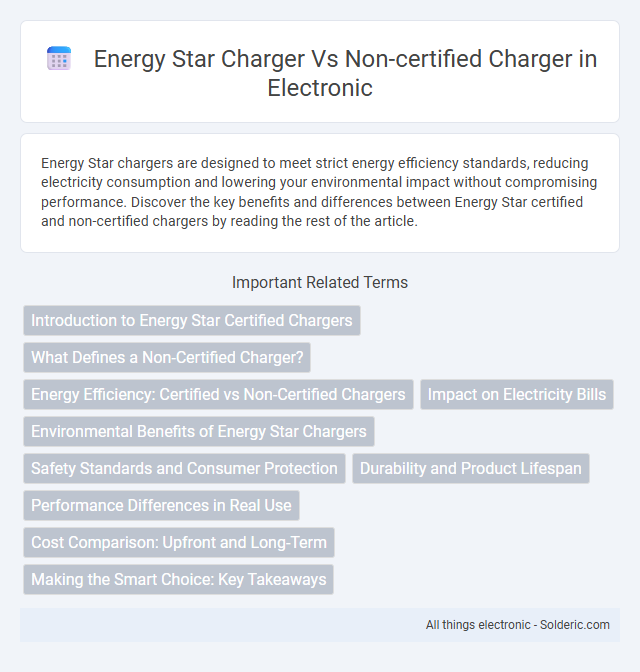Energy Star chargers are designed to meet strict energy efficiency standards, reducing electricity consumption and lowering your environmental impact without compromising performance. Discover the key benefits and differences between Energy Star certified and non-certified chargers by reading the rest of the article.
Comparison Table
| Feature | Energy Star Charger | Non-Certified Charger |
|---|---|---|
| Energy Efficiency | Meets strict Energy Star efficiency standards, reduces power consumption | Often lacks efficiency, higher energy waste |
| Power Output | Consistent and optimized for device compatibility | Variable output, may cause slower charging or device damage |
| Environmental Impact | Lower carbon footprint due to reduced energy usage | Higher environmental impact due to inefficiency |
| Safety Standards | Complies with strict safety and quality regulations | May not meet safety standards, potential risks of overheating or electrical faults |
| Cost Efficiency | Potential long-term savings via reduced electricity bills | Lower initial cost but higher operating expenses |
| Certification | Certified by Energy Star program | No official certification |
Introduction to Energy Star Certified Chargers
Energy Star certified chargers meet strict energy efficiency guidelines set by the U.S. Environmental Protection Agency, ensuring reduced power consumption and lower environmental impact compared to non-certified chargers. These chargers deliver high performance while minimizing energy waste, which saves you money on electricity bills and supports sustainability efforts. Choosing an Energy Star charger guarantees your device charges efficiently with less heat generation and longer product lifespan.
What Defines a Non-Certified Charger?
A non-certified charger lacks official Energy Star certification, indicating it may not meet established energy efficiency and safety standards set by the EPA. These chargers often consume more power during use and standby, increasing energy costs and environmental impact. Their build quality can vary widely, presenting higher risks of overheating, electrical faults, and reduced device longevity compared to certified models.
Energy Efficiency: Certified vs Non-Certified Chargers
Energy Star chargers deliver superior energy efficiency by consuming up to 30% less power compared to non-certified chargers, reducing electricity costs and environmental impact. Non-certified chargers often have higher standby power losses, wasting energy even when devices are fully charged or disconnected. Your choice of an Energy Star certified charger ensures optimal power use, enhancing sustainability without compromising performance.
Impact on Electricity Bills
Energy Star chargers consume up to 30% less electricity than non-certified chargers, resulting in significant savings on electricity bills over time. These chargers meet strict energy efficiency guidelines set by the U.S. Environmental Protection Agency, minimizing power waste during charging and standby modes. Choosing an Energy Star-certified charger reduces overall energy consumption, lowering household electricity costs and environmental impact.
Environmental Benefits of Energy Star Chargers
Energy Star chargers reduce energy consumption by meeting strict efficiency standards, which lowers greenhouse gas emissions and conserves natural resources. Unlike non-certified chargers, they minimize power waste during both active use and standby modes, promoting sustainable energy use. Choosing an Energy Star charger helps you decrease your carbon footprint and supports global efforts toward environmental protection.
Safety Standards and Consumer Protection
Energy Star chargers comply with rigorous safety standards set by the Environmental Protection Agency (EPA), ensuring reduced risks of overheating, electrical shock, and fire hazards compared to non-certified chargers. These certified chargers undergo extensive testing for efficiency and safety, providing enhanced consumer protection against product malfunctions and potential harm. Non-certified chargers often lack this level of scrutiny, increasing the likelihood of safety issues and unreliable performance.
Durability and Product Lifespan
Energy Star chargers typically exhibit enhanced durability due to stringent energy efficiency and quality standards, resulting in longer product lifespans compared to non-certified chargers. Built with higher-grade materials and advanced components, these chargers resist wear and overheating, minimizing the risk of premature failure. Non-certified chargers often use inferior parts, leading to reduced durability and shorter operational life spans, which can increase electronic waste and replacement costs.
Performance Differences in Real Use
Energy Star chargers deliver higher energy efficiency, reducing electricity consumption by up to 50% compared to non-certified chargers, leading to lower operational costs and minimal heat generation during use. Your devices charge faster and more safely with Energy Star-certified chargers due to built-in smart technology that prevents overcharging and power surges. Non-certified chargers often lack these protections, increasing the risk of slower charging, device damage, and energy waste.
Cost Comparison: Upfront and Long-Term
Energy Star chargers typically have a higher upfront cost compared to non-certified chargers but deliver significant long-term savings through enhanced energy efficiency and reduced electricity bills. Non-certified chargers may be cheaper initially but often consume more power, leading to increased operational costs over time. Investing in an Energy Star charger benefits your wallet by minimizing energy waste and lowering total ownership expenses.
Making the Smart Choice: Key Takeaways
Choosing an Energy Star charger ensures higher energy efficiency, reducing power consumption and lowering electricity bills compared to non-certified chargers. These chargers meet strict environmental guidelines, minimizing emissions and promoting sustainability in everyday device usage. Your decision to invest in Energy Star-certified products supports eco-friendly practices while delivering reliable performance and long-term cost savings.
Energy Star charger vs Non-certified charger Infographic

 solderic.com
solderic.com